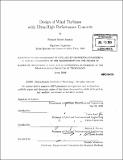| dc.contributor.advisor | Franz-Josef Ulm. | en_US |
| dc.contributor.author | Jammes, François-Xavier | en_US |
| dc.contributor.other | Massachusetts Institute of Technology. Dept. of Civil and Environmental Engineering. | en_US |
| dc.date.accessioned | 2010-02-09T16:46:45Z | |
| dc.date.available | 2010-02-09T16:46:45Z | |
| dc.date.copyright | 2009 | en_US |
| dc.date.issued | 2009 | en_US |
| dc.identifier.uri | http://hdl.handle.net/1721.1/51574 | |
| dc.description | Thesis (M. Eng.)--Massachusetts Institute of Technology, Dept. of Civil and Environmental Engineering, 2009. | en_US |
| dc.description | Includes bibliographical references (leaves 72-73). | en_US |
| dc.description.abstract | Ultra-High Performance Concrete (UHPC) has proven an asset for bridge design as it significantly reduces costs. However, UHPC has not been applied yet to wind turbine technology. Design codes do not propose any recommendations or guidance for the towers, thus encouraging the engineer to use less effective traditional materials like steel. The purpose of this thesis is to propose an efficient way to design UHPC wind turbines. First is explained the strategy to retain an optimal design. Then, the comparison with a similar steel model demonstrates that UHPC is both an economical and sustainable design solution for towers. This work is based on a combination of the UHPC 1D model developed at MIT and the interim recommendations provided by Association Franqaise de Genie Civil. The expression of the design loads and the resistant loads for a UHPC circular hollow section are presented based on available design codes. Then, the optimization process based on the previous model is established. It is achieved using two programs in order to satisfy both the Service Limit State (SLS) and the Ultimate Limit State (ULS). The best design is obtained for a SLS criteria deflection of L/800. The cost of material is reduced by a factor between 2 and 3 in comparison with traditional steel. All of this confirms that UHPC could be an innovative engineering solution for the realization of new wind turbine towers. | en_US |
| dc.description.statementofresponsibility | by François-Xavier Jammes. | en_US |
| dc.format.extent | 73 leaves | en_US |
| dc.language.iso | eng | en_US |
| dc.publisher | Massachusetts Institute of Technology | en_US |
| dc.rights | M.I.T. theses are protected by
copyright. They may be viewed from this source for any purpose, but
reproduction or distribution in any format is prohibited without written
permission. See provided URL for inquiries about permission. | en_US |
| dc.rights.uri | http://dspace.mit.edu/handle/1721.1/7582 | en_US |
| dc.subject | Civil and Environmental Engineering. | en_US |
| dc.title | Design of wind turbines with Ultra-High Performance Concrete | en_US |
| dc.title.alternative | Design of wind turbines with UHPC | en_US |
| dc.type | Thesis | en_US |
| dc.description.degree | M.Eng. | en_US |
| dc.contributor.department | Massachusetts Institute of Technology. Department of Civil and Environmental Engineering | |
| dc.identifier.oclc | 491290497 | en_US |
